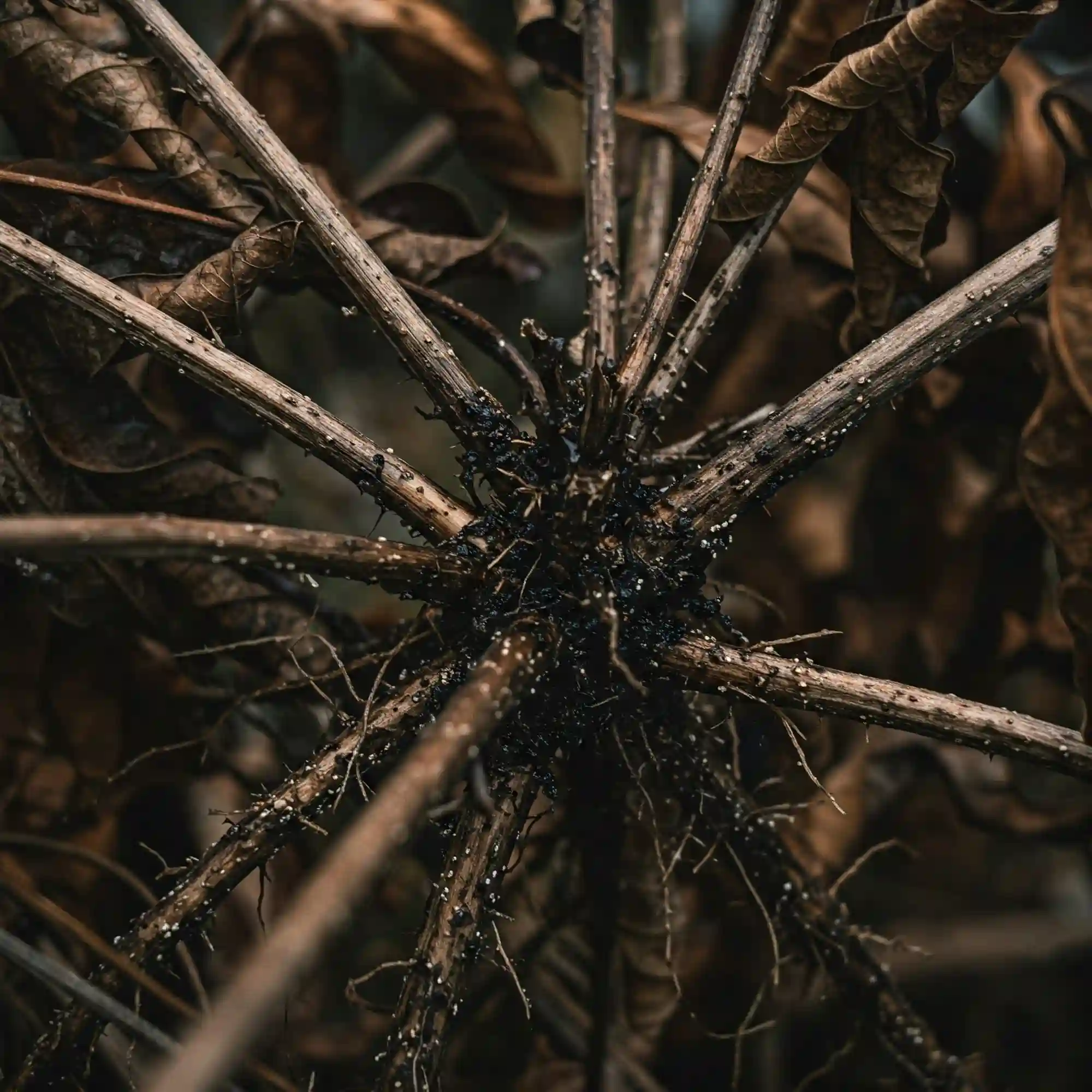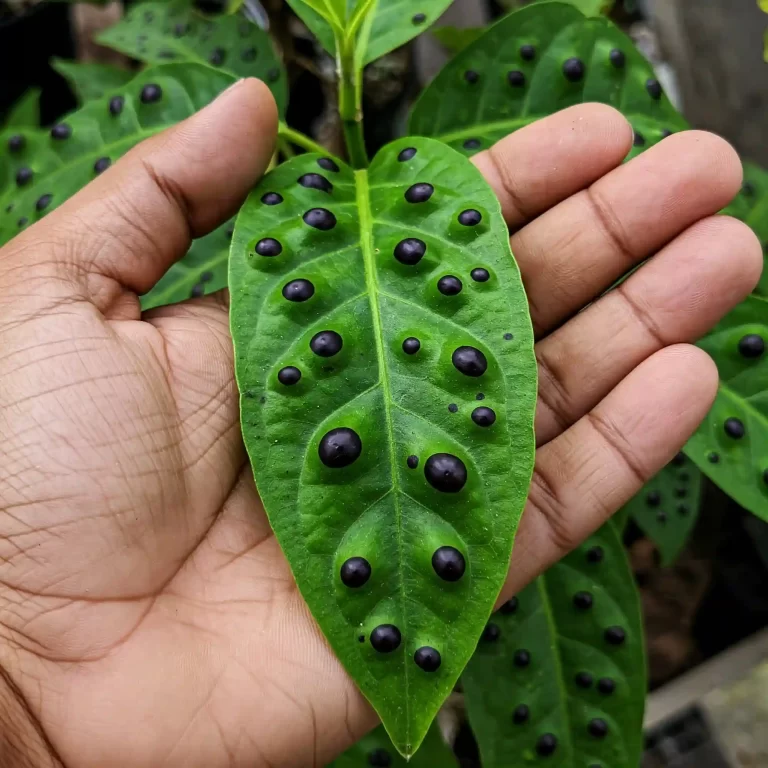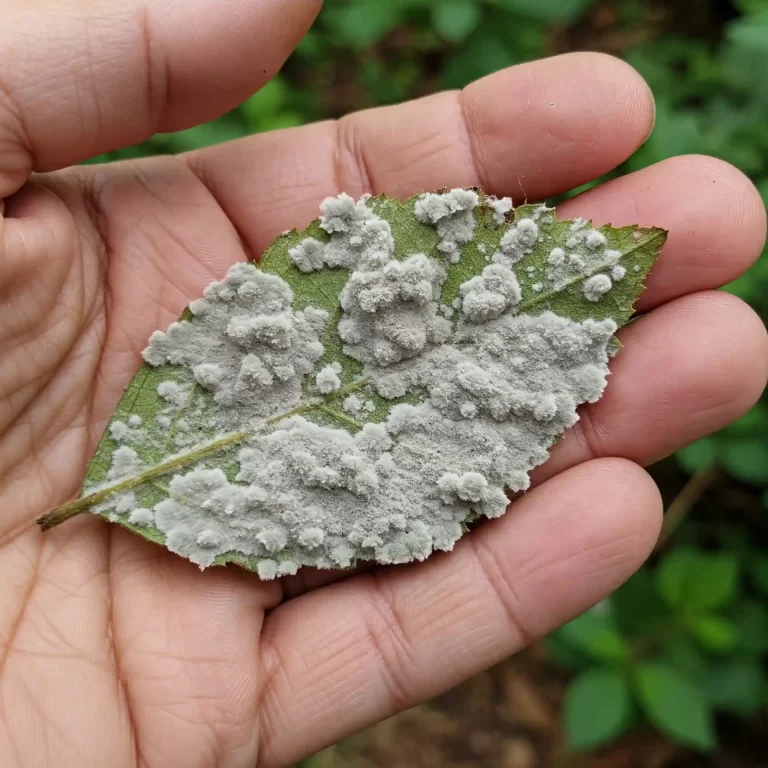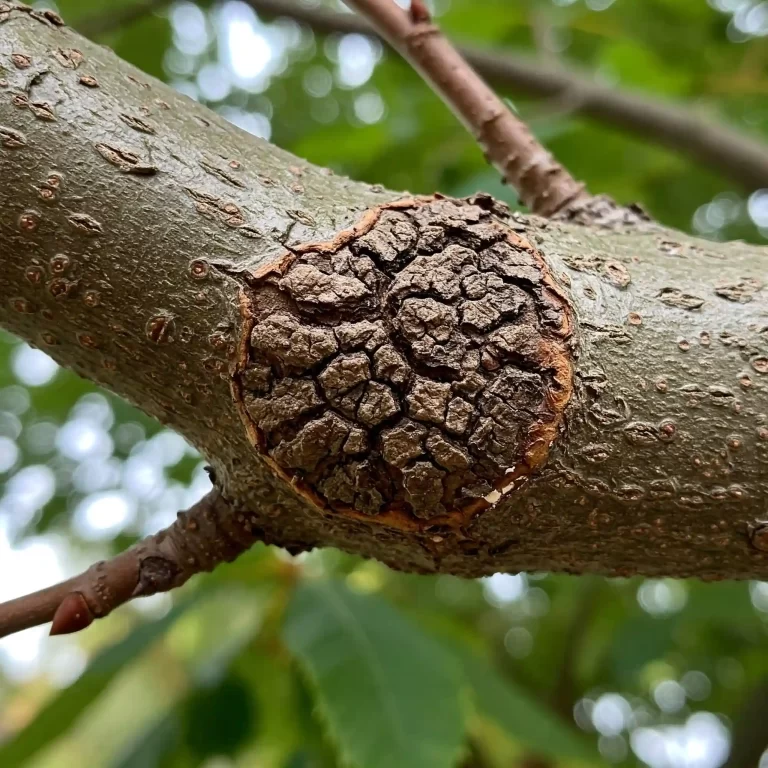Have you noticed your plants wilting inexplicably, even when you’ve been watering them diligently? The creeping dread of a hidden disease can be overwhelming, especially when your hard work seems to be fading before your eyes. It’s frustrating to watch your garden suffer, right? I understand that feeling of helplessness. You’ve invested time, effort, and care, only to see your plants succumb to an unseen enemy. But there’s a solution: understanding and combating charcoal rot. By recognizing its symptoms and implementing targeted control measures, you can protect your garden and restore its vitality. Let’s tackle this problem together.
1. Spotting the Silent Threat: Recognizing Charcoal Rot Symptoms
Charcoal rot, a subtle yet insidious disease, can wreak havoc in your garden if left unchecked. Recognizing its early symptoms is crucial for timely intervention and minimizing damage. While the initial signs might seem innocuous, a keen eye and a little knowledge can help you identify this silent threat before it takes a significant toll on your plants.
One of the most common early signs of charcoal rot is unexplained wilting. You might notice that your plants are drooping and looking lackluster, even though you’ve been watering them regularly. This wilting, however, is not a simple case of thirst. Charcoal rot attacks the plant’s vascular system, hindering its ability to transport water and nutrients. As a result, the plant struggles to stay hydrated and suffers from a gradual decline.
Beyond wilting, you’ll want to closely examine the base of the plant and its roots. Lesions, or dark, discolored areas, will start to appear. These lesions are a telltale sign of charcoal rot, indicating that the fungus is actively damaging the plant tissue. The severity of the lesions can vary, but they often appear as sunken, dark brown to black patches on the stems and roots.
Another characteristic symptom is the presence of sclerotia. These are small, black, bead-like structures that resemble tiny pieces of charcoal—hence the name “charcoal rot.” Sclerotia are the resting structures of the fungus, enabling it to survive in the soil even when conditions are unfavorable for active growth. They can be found on the infected plant tissue, particularly near the soil line.
To help you better understand the specific symptoms in different plants, let’s consider some examples:
- Soybeans: You might observe reddish-brown lesions on the stem near the soil line, accompanied by yellowing and wilting of the leaves.
- Tomatoes: The lower leaves may start to yellow and wilt, while the stem develops dark lesions near the soil line.
- Melons: Sudden wilting and vine collapse are common symptoms, along with the appearance of dark, sunken lesions on the stems.
- Sunflowers: You might notice premature wilting and discoloration of the stem, with the pith of the stem becoming shredded.
It’s important to differentiate charcoal rot from other root diseases that can cause similar symptoms. For example, Pythium root rot can also lead to wilting, but it typically causes a softer, more mushy rot, while charcoal rot results in dry, dark lesions. Fusarium wilt can also cause wilting, but the symptoms usually involve discoloration of the plant’s vascular tissue.
Here’s a table summarizing the key differences:
| Symptom | Charcoal Rot | Pythium Root Rot | Fusarium Wilt |
| Wilting | Yes, often sudden | Yes, but slower | Yes, progressive |
| Lesions | Dry, dark, with sclerotia | Mushy, water-soaked | Vascular discoloration |
| Sclerotia | Small, black, bead-like | Absent | Absent |
| Root Appearance | Dry, discolored | Soft, decayed | Discolored vascular tissue |
Early detection is crucial when dealing with charcoal rot. By carefully examining your plants for these characteristic symptoms and comparing them to other potential causes, you can take swift action to protect your garden. Remember that Macrophomina phaseolina, the fungus responsible for charcoal rot, thrives in warm, dry conditions. Therefore, be particularly vigilant during periods of hot, dry weather.
By understanding the subtle signs and recognizing the unique characteristics of charcoal rot, you can effectively combat this disease and ensure a healthy and productive garden.
2. The Culprit Unveiled: Understanding Macrophomina Phaseolina
Now that we’ve explored the symptoms of charcoal rot, let’s delve into the heart of the matter: the culprit behind this destructive disease. The primary antagonist is a soil-borne fungus known as Macrophomina phaseolina. This microscopic organism is a master of disguise, lurking in the soil, patiently waiting for the right conditions to strike.
Macrophomina phaseolina is a fascinating and complex organism. It’s a necrotrophic fungus, meaning it feeds on dead plant cells. It produces a variety of enzymes that break down plant tissues, allowing the fungus to colonize and spread within the plant. One of the most distinctive features of this fungus is its ability to form sclerotia. These sclerotia are compact, dark-colored structures that act as survival mechanisms for the fungus. They can remain dormant in the soil for years, waiting for favorable conditions to germinate and infect new plants.
The life cycle of Macrophomina phaseolina is intricately linked to environmental factors. High soil temperatures and drought stress create ideal conditions for the fungus to thrive. When the soil temperature rises above 80°F (27°C), the fungus becomes highly active. Additionally, drought stress weakens plants, making them more susceptible to infection. As the plant’s defenses weaken, the fungus takes advantage, rapidly colonizing the roots and stems.
Understanding the behavior of Macrophomina phaseolina is crucial for effective disease management. By recognizing the environmental factors that favor its growth, you can implement strategies to minimize the risk of infection.
Here are some key points to remember about this formidable fungus:
- Soil-borne pathogen: Macrophomina phaseolina primarily resides in the soil.
- Necrotrophic fungus: It feeds on dead plant cells.
- Sclerotia: These resting structures enable the fungus to survive in the soil for extended periods.
- Temperature and drought stress: Favorable conditions for the fungus to thrive.
By understanding the biology and behavior of this pathogen, you can take proactive steps to protect your garden and minimize the impact of charcoal rot.
3. Preventative Measures: Building a Strong Defense
Prevention is always better than cure, and this adage rings particularly true when it comes to charcoal rot. By implementing a proactive approach and building a strong defense for your garden, you can significantly reduce the risk of this disease taking hold. Focusing on soil health is paramount. Healthy soil is teeming with beneficial microorganisms that compete with harmful pathogens like Macrophomina phaseolina.
One of the most effective preventative measures is to maintain optimal soil moisture. While drought stress can exacerbate charcoal rot, waterlogged conditions can also create an environment conducive to fungal growth. Strive to maintain consistent soil moisture levels, avoiding both drought and excessive watering. Deep watering encourages deep root growth, which can help plants withstand periods of drought and access nutrients more efficiently.
Crop rotation is another powerful tool in your arsenal. By rotating your crops, you break the disease cycle. Avoid planting susceptible crops in the same location year after year. This helps to reduce the build-up of Macrophomina phaseolina sclerotia in the soil.
Selecting resistant varieties can also provide a significant advantage. Research and choose plant varieties that have been bred for resistance to charcoal rot. This can greatly reduce the risk of infection and protect your garden from this destructive disease.
Beyond these core strategies, several other practices can contribute to a robust defense against charcoal rot:
- Sanitation: Remove and destroy infected plant debris to prevent the spread of the disease.
- Soil solarization: This technique involves covering the soil with clear plastic sheeting to trap heat and kill soil-borne pathogens, including Macrophomina phaseolina.
- Cover crops: Planting cover crops between growing seasons can help improve soil health, suppress weeds, and reduce the population of soil-borne pathogens.
By implementing these preventative measures and prioritizing soil health, you can create a more resilient garden ecosystem that is less susceptible to charcoal rot. Remember, a healthy garden is a strong garden, capable of withstanding the challenges posed by this and other diseases.
4. Effective Control: Treatment Options for Infected Plants
While prevention is always the preferred approach, sometimes charcoal rot can take hold despite your best efforts. In such cases, it’s important to act quickly and implement effective control measures to minimize damage and prevent the disease from spreading.
Fungicides are often the first line of defense against charcoal rot. There are several fungicides available that can help manage the disease. Some commonly used options include:
- Myclobutanil: This fungicide is effective at controlling a wide range of fungal diseases, including charcoal rot.
- Fludioxonil: This fungicide is known for its systemic action, meaning it is absorbed by the plant and translocated throughout the plant tissues.
- Azoxystrobin: This fungicide is a broad-spectrum fungicide that can help protect plants from a variety of fungal pathogens, including Macrophomina phaseolina.
It’s important to follow the instructions on the fungicide label carefully, including the recommended application rates and timing. Remember to always prioritize safety when handling and applying fungicides. Wear appropriate protective gear, such as gloves and eye protection, and avoid spraying on windy days to prevent drift.
In addition to chemical fungicides, biological control methods can also be explored. Some beneficial soil microorganisms can help suppress the growth of Macrophomina phaseolina. These microorganisms can compete with the pathogen for resources, produce antifungal compounds, or stimulate plant defenses. However, the effectiveness of biological control methods can vary depending on the specific circumstances.
Once you’ve applied treatment, it’s crucial to monitor the infected plants closely. Continue to water and fertilize them appropriately to support their recovery. Remove and destroy any severely infected plants to prevent the disease from spreading further.
Remember, controlling charcoal rot is an ongoing process. Even after treatment, continue to monitor your plants for any signs of the disease. Implement preventative measures, such as crop rotation and soil health management, to reduce the risk of future outbreaks.
5. Soil Sterilization: Eliminating the Pathogen
In severe cases of charcoal rot infestation, particularly when the disease has become widespread in the garden, more drastic measures may be necessary. Soil sterilization is one such approach, although it should be considered a last resort due to its potential impact on soil health and the broader ecosystem.
Soil sterilization involves treating the soil to eliminate harmful pathogens, including Macrophomina phaseolina. There are several methods for achieving this, each with its own set of advantages and drawbacks:
- Heat treatment: This involves heating the soil to temperatures that are lethal to the pathogen. This can be done using steam or solarization. Steam sterilization is a professional method that requires specialized equipment, while solarization involves covering the soil with clear plastic sheeting to trap heat from the sun.
- Chemical sterilization: This involves applying chemical fumigants to the soil. These chemicals can effectively kill soil-borne pathogens, but they can also have negative impacts on soil health and the environment. It’s crucial to follow all safety precautions and use these chemicals responsibly.
Soil sterilization should be considered carefully, as it can disrupt the delicate balance of the soil ecosystem. Beneficial microorganisms that play a vital role in soil health can also be killed during the process. Therefore, it’s essential to take steps to restore soil health after sterilization. Adding organic matter, such as compost or well-rotted manure, can help reintroduce beneficial microorganisms and improve soil structure.
It’s important to note that soil sterilization is not always necessary. In many cases, implementing preventative measures and using less drastic treatment options can effectively manage charcoal rot. If you are considering soil sterilization, it’s advisable to consult with a local agricultural extension agent or a soil specialist to determine the most appropriate method and to discuss the potential risks and benefits.
6. Care After Infection: Restoring Plant Health
Even after you’ve successfully treated an infection, it’s crucial to provide the necessary care to help your plants recover and prevent future outbreaks. Remember, charcoal rot can weaken plants, making them more susceptible to other stresses.
One of the most important steps is to support the plant’s overall health. Provide adequate water and nutrients to encourage new growth. You can use a balanced fertilizer to replenish the nutrients that may have been lost during the infection. Avoid over-fertilizing, as this can stress the plant and make it more vulnerable.
Pruning away severely infected plant parts can also help prevent the disease from spreading further. This can include removing wilted or discolored leaves, stems, and roots. Be sure to sterilize your pruning tools between cuts to prevent the spread of the disease.
Improving soil drainage can also be beneficial. Charcoal rot thrives in poorly drained soils, where water can accumulate and create a favorable environment for the fungus. If your soil tends to be heavy or compacted, consider amending it with organic matter like compost or well-rotted manure to improve drainage and aeration.
Mulching around the base of your plants can help to conserve soil moisture and regulate soil temperature. Mulch can also help to suppress weeds, which can compete with plants for water and nutrients.
Remember, restoring plant health after an infection takes time and patience. Continue to monitor your plants closely and adjust your care practices as needed. By providing the necessary support and creating a conducive environment, you can help your plants recover and thrive.
7. Climate and Charcoal Rot: Adapting to Your Environment
Climate plays a significant role in the development and spread of charcoal rot. Understanding the specific climatic conditions in your region can help you adapt your gardening practices and minimize the impact of this disease.
Hot and dry conditions are particularly favorable for the growth of Macrophomina phaseolina. High soil temperatures and drought stress weaken plants, making them more susceptible to infection. In regions with hot summers and limited rainfall, the risk of charcoal rot is significantly increased.
Humidity and rainfall can also influence disease development. While excessive moisture can create favorable conditions for other fungal diseases, moderate rainfall can help to cool the soil and reduce the risk of charcoal rot. However, prolonged periods of high humidity can also create a conducive environment for the fungus to thrive.
By understanding the specific climatic conditions in your region, you can implement strategies to mitigate the risk of charcoal rot:
- Irrigation: In hot, dry climates, provide adequate irrigation to prevent drought stress. However, avoid overwatering, as this can create waterlogged conditions that can favor the growth of other pathogens.
- Mulching: Applying a layer of mulch around your plants can help to conserve soil moisture, regulate soil temperature, and suppress weeds.
- Crop rotation: Rotating crops can help to break the disease cycle and reduce the build-up of Macrophomina phaseolina in the soil.
In addition to climate, other environmental factors can also influence the development of charcoal rot. Soil type, for example, can play a role. Sandy soils, which tend to warm up quickly and dry out easily, can be more susceptible to charcoal rot in hot weather.
By carefully considering the climatic conditions in your region and adapting your gardening practices accordingly, you can create a more resilient garden that is better able to withstand the challenges posed by charcoal rot.
8. Long-Term Protection: Maintaining a Healthy Garden Ecosystem
While we’ve discussed various strategies for managing and treating charcoal rot, the most effective approach lies in creating a healthy and resilient garden ecosystem. A thriving garden is a complex and interconnected system where every element plays a crucial role. By fostering biodiversity and implementing sustainable practices, you can create a natural defense against diseases like charcoal rot.
Biodiversity is key to a healthy garden ecosystem. Planting a variety of plants, including flowers, vegetables, and herbs, can attract beneficial insects and pollinators. These beneficial organisms can help to control populations of harmful pests and diseases. For example, certain insects can prey on the pests that transmit diseases, while others can help to decompose organic matter and improve soil health.
Integrated pest management (IPM) is a holistic approach to managing pests and diseases in the garden. It involves a combination of techniques, including cultural practices, biological controls, and the judicious use of chemical controls. By carefully monitoring your plants and implementing a range of strategies, you can minimize the need for harsh chemicals and create a more sustainable and environmentally friendly garden.
Soil health is another critical component of a resilient garden ecosystem. Healthy soil is teeming with beneficial microorganisms that compete with pathogens, break down organic matter, and improve nutrient cycling. Practices such as composting, cover cropping, and avoiding excessive tillage can help to maintain and improve soil health.
Building a healthy garden ecosystem is an ongoing process. It requires continuous observation, experimentation, and a commitment to sustainable practices. By creating a balanced and diverse environment, you can minimize the risk of charcoal rot and other diseases, while promoting the overall health and vitality of your garden.
Remember, a healthy garden is more than just a collection of plants. It’s a complex and interconnected system where every element plays a crucial role. By understanding the principles of ecosystem health and implementing sustainable practices, you can create a garden that is not only beautiful but also resilient and productive.
FAQ
Q: How to identify charcoal rot in tomato plants?
A: Charcoal rot in tomato plants often presents as sudden wilting, even when the soil is adequately moist. You’ll likely notice dark, discolored lesions at the base of the stem, near the soil line. The leaves may turn yellow and wilt, and you might even observe small, black sclerotia (resting structures of the fungus) on the affected plant tissue.
Q: Effective ways to prevent charcoal rot in soybean crops?
A: Several strategies can help prevent charcoal rot in soybean crops. These include:
- Crop rotation: Rotating soybeans with non-host crops can help to break the disease cycle and reduce the build-up of Macrophomina phaseolina in the soil.
- Planting resistant varieties: Selecting soybean varieties that have been bred for resistance to charcoal rot can significantly reduce the risk of infection.
- Maintaining optimal soil moisture: While drought stress can exacerbate charcoal rot, waterlogged conditions can also create a favorable environment for the fungus. Strive to maintain consistent soil moisture levels through proper irrigation practices.
Q: What are the best fungicides for charcoal rot treatment?
A: Several fungicides can be effective in controlling charcoal rot. Some commonly used options include:
- Myclobutanil: This broad-spectrum fungicide is effective against a wide range of fungal diseases, including charcoal rot.
- Fludioxonil: This fungicide is known for its systemic action, meaning it is absorbed by the plant and translocated throughout the plant tissues.
- Azoxystrobin: This fungicide is another broad-spectrum option that can help protect plants from a variety of fungal pathogens.
It’s important to follow the label instructions carefully when using any fungicide. Always wear appropriate protective gear and avoid spraying on windy days to prevent drift.
Q: Causes of charcoal rot in melons during hot weather?
A: High soil temperatures and drought stress are the primary causes of charcoal rot in melons during hot weather. These conditions create an ideal environment for the growth of Macrophomina phaseolina. When soil temperatures rise above 80°F (27°C), the fungus becomes highly active. Additionally, drought weakens the plant’s defenses, making it more susceptible to infection.
Q: Natural remedies for charcoal rot on sunflower stems?
A: While chemical fungicides are often necessary for controlling charcoal rot, some natural remedies may also be helpful. These include:
- Improving soil health: Practices such as composting and cover cropping can improve soil health and promote the growth of beneficial microorganisms that can help to suppress the fungus.
- Maintaining adequate soil moisture: Consistent watering can help to reduce stress on the plants and minimize the impact of drought.
- Removing and destroying infected plants: This can help to prevent the spread of the disease to other plants.
Q: Understanding charcoal rot symptoms and soil temperature correlation?
A: Charcoal rot symptoms, such as wilting and stem lesions, often become more pronounced in hot weather. This is because high soil temperatures create ideal conditions for the growth and activity of Macrophomina phaseolina. As the soil temperature rises, the fungus becomes more active, leading to a more rapid progression of the disease.
Q: Charcoal rot impact on corn yield and preventative measures?
A: Charcoal rot can significantly impact corn yield. The disease can cause stunted growth, reduced ear size, and premature death of plants. Preventative measures include:
- Planting resistant varieties: Selecting corn varieties that have been bred for resistance to charcoal rot.
- Maintaining optimal soil moisture: Avoid both drought stress and waterlogging.
- Crop rotation: Rotating corn with non-host crops can help to reduce the build-up of the pathogen in the soil.
Q: Diagnosing and treating charcoal rot in bean root systems?
A: Diagnosing charcoal rot in bean root systems involves examining the roots for dark, discolored lesions. You may also observe wilting and yellowing of the leaves. Treatment options include applying appropriate fungicides and improving soil drainage.
Q: Best practices for soil sterilization to avoid charcoal rot?
A: Soil sterilization should be considered a last resort, as it can disrupt the soil ecosystem. However, if necessary, methods such as steam sterilization or solarization can be used to kill soil-borne pathogens, including Macrophomina phaseolina. It’s crucial to follow proper procedures and take precautions to minimize the impact on soil health.
Q: How does drought stress contribute to charcoal rot development?
A: Drought stress weakens plants, making them more susceptible to infection by Macrophomina phaseolina. When plants are under water stress, their natural defenses are compromised, allowing the fungus to more easily invade and colonize plant tissues.
Conclusion:
Charcoal rot can be a significant challenge for gardeners, but by understanding the disease and implementing the strategies outlined in this article, you can effectively protect your plants and maintain a thriving garden. Remember, prevention is key. Focus on building a healthy garden ecosystem, practicing good sanitation, and monitoring your plants regularly for signs of infection. By taking a proactive approach and adapting your practices to your specific environment, you can minimize the impact of charcoal rot and enjoy a bountiful harvest year after year.
Additional Tips:
- Keep detailed records of your garden activities, including planting dates, fertilization schedules, and any observed symptoms. This information can be valuable in identifying patterns and developing effective management strategies.
- Consult with local experts, such as master gardeners or agricultural extension agents, for advice on managing charcoal rot in your specific region.
- Stay informed about the latest research and management strategies for charcoal rot. By staying up-to-date on the latest information, you can make informed decisions and adapt your practices as needed.
By following these tips and implementing a proactive approach, you can successfully manage charcoal rot and ensure a healthy and productive garden for years to come.




